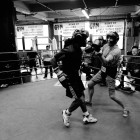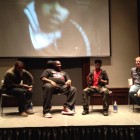
OP-ED: Holidays in the Juvenile Justice System
|
Missing a holiday with the dozens of brothers, sisters, nieces, nephews, cousins, aunts and uncles got me to wondering – what is the holiday experience for a kid in detention?
Juvenile Justice Information Exchange (https://jjie.org/page/300/)

In late September, Torri was driving down the highway with her 11-year-old son Junior in the back seat when her phone started ringing.
It was the Hamilton County Sheriff’s deputy who worked at Junior’s middle school in Chattanooga, Tennessee. Deputy Arthur Richardson asked Torri where she was. She told him she was on the way to a family birthday dinner at LongHorn Steakhouse.
“He said, ‘Is Junior with you?’” Torri recalled.
Earlier that day, Junior had been accused by other students of making a threat against the school. When Torri had come to pick him up, she’d spoken with Richardson and with administrators, who’d told her he was allowed to return to class the next day. The principal had said she would carry out an investigation then. ProPublica and WPLN are using a nickname for Junior and not including Torri’s last name at the family’s request, to prevent him from being identifiable.
When Richardson called her in the car, Torri immediately felt uneasy. He didn’t say much before hanging up, and she thought about turning around to go home. But she kept driving. When they walked into the restaurant, Torri watched as Junior happily greeted his family.
Soon her phone rang again. It was the deputy. He said he was outside in the strip mall’s parking lot and needed to talk to Junior. Torri called Junior’s stepdad, Kevin Boyer, for extra support, putting him on speaker as she went outside to talk to Richardson. She left Junior with the family, wanting to protect her son for as long as she could ...

Missing a holiday with the dozens of brothers, sisters, nieces, nephews, cousins, aunts and uncles got me to wondering – what is the holiday experience for a kid in detention?

Today on Bokeh, Robert Stolarik's photos of two men confronting very different demons in the boxing ring.

On a bitter cold winter January morning in 2008, Adam Friedman and Alvin Valentine, friends and co-workers, climbed into a Brooklyn boxing ring and proceeded to go after each other for three hard-hitting rounds.

"First-degree murder is a serious crime, and it carries with it serious consequences," attorney general Bill Schuette said in a news release.

When it comes to high risk for suicide, youth in contact with the juvenile justice system stand out. It is alarming. Fortunately, staff within the system can play a crucial preventive role by working collectively to provide guidance, support and access to needed care. Studies show that up to 70 percent of youth in the system have a behavioral health problem, and for a large percentage, one or more life functions are significantly affected. An at-risk youth’s past nearly always includes multiple adverse childhood events; this, combined with the sense of hopelessness and isolation that ensues from the experience of confinement, increases the suicide risk for these youth to a level dramatically higher than for youth outside the system.

Gangsta rap, the form of hip-hop music containing lyrics about urban crime and violence, should really be viewed as a commentary on how to address racist law enforcement in the inner city. But instead, the genre’s hardcore style, spurred by the record industry, has widely stereotyped African-American males as criminals. This was the theme of an October lecture at the Chicago Bar Association by Donald F. Tibbs an associate professor of law at Drexel University, specializing in race, civil rights and criminal procedure. Professor Tibbs’ talk was titled “Hip Hop and Its Influence on Criminal Law.”
“I’m plagued by…how art is now being used as a site of dispossession for young black men,” he said. “More specifically I’m concerned about how the state is using lyrics from rap music to prosecute black males in criminal trials.”
According to Tibbs, pop culture, extending from rap music to TV crime dramas like the “Law & Order” franchise, “Detroit 1-8-7,” “Gangland,” “Cops” and “Dog the Bounty Hunter,” promotes an idea that “criminal defendants are always guilty until proven innocent through forensic evidence.”
Moreover, he noted, “Each of these iconic pop-culture shows features the same story line, meaning that people who are black, brown and immigrant is the baseline for establishing criminality.”
To illustrate his point, Tibbs used the 2012 conviction of Darin K. Wright for third-degree murder in a case in which Wright shot a man following an argument on a Philadelphia street.

Earlier this week Buckshot and DJ Evil Dee, founding members of the legendary, Brooklyn-based hip-hop group Black Moon, joined forces with the Brooklyn Historical Society and Brooklyn Bodega to discuss the 20th anniversary of their debut album, “Enta Da Stage,” as well as to talk about hip-hop's unprecedented popularity and ever-increasing influence on today’s young people.

The myth of Thanksgiving is deeply embedded in American culture. I can remember cutting out paper turkeys and making pilgrim hats and Indian headdresse as a small childs. The teachers would tell us the story of the near starving pilgrims, saved by the Indians. Visions of Squanto, fish heads, maize and peaceful coexistence made for a nice story that I never had reason to doubt. As an adult I have learned more about the history of Thanksgiving, including how the story we tell is mostly historically inaccurate.